|
The design of the fireplace or stove can contribute to either spillage resistance or the likelihood of the system to spill. Although there are several appliance characteristics that affect spillage performance, one characteristic tends to dominate all others: the demand for combustion and dilution air. Generally, the less air an appliance needs for proper operation, the more resistant to spillage it will be. The following list of chimney vented hearth categories is presented in approximate order of the least to the most spillage resistant:
- open fireplaces (wood or gas log)
- gas appliances with draft hoods (space heaters, inserts, fireplaces)
- conventional masonry or factory-built fireplaces with doors but no gaskets
- controlled combustion woodburning appliances
- EPA certified woodburning appliances
Note that some other characteristics of an appliance within a category may effect its spillage resistance and change its ranking.
The presence of a solid barrier between the room and the combustion chamber increases spillage resistance dramatically. This effect is not simply because doors keep the smoke inside by providing fewer leakage sites. In fact, it has more to do with higher gas temperatures and stronger draft because less dilution air is admitted.
EPA certified appliances tend to be more spillage resistant than other appliances having similar tightness because their combustion systems provide more stable combustion and so are less likely to smolder. Firebox insulation and a more complex internal structure also gives EPA certified stoves and fireplace more mass and therefore more energy momentum than conventional equipment.
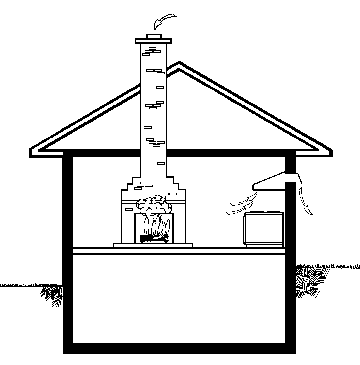 |
An open fireplace without doors has almost no spillage resistance during a significant part of the burn cycle because there is no barrier provided between the combustion process and the room. |
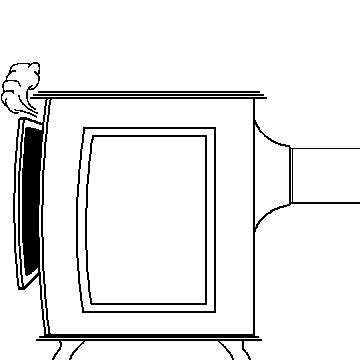 |
An appliance with a firebox exhaust exit that is lower than the top of the door opening is more susceptible to open door spillage. |
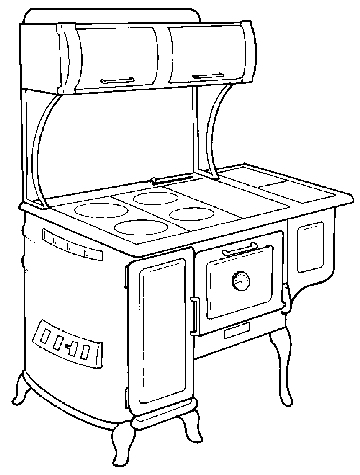 |
An appliance that has leaky joints is more susceptible to spillage. Cook stoves commonly spill combustion gases from their leaky cooking surfaces, either when the door is opened for fuelling, or when the door is closed if draft falls to very low levels. |
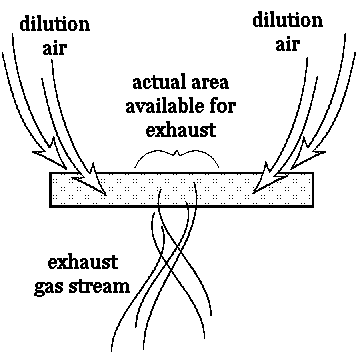 |
An appliance in which the firebox outlet is in the shape of a narrow slot is more susceptible to spillage when the loading door is opened than one with a round outlet because the flow of dilution air tends to block much of the exhaust opening. Examples of such appliances are conventional masonry fireplaces and wood stoves with horizontal baffles. |
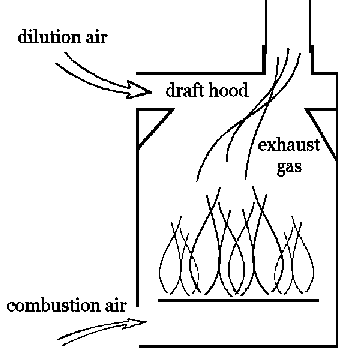 |
Gas and propane appliances with draft hoods are considered to be "open" in the same way we refer to fireplaces without doors as being open, in that there is no boundary separating the flue gas passage from the room. As a result, they are about as susceptible to spillage as open fireplaces. |
What you can do about appliance design
Aside from replacing gaskets and cementing cast iron joints in order to reduce leakage, you may be unable to modify the appliance to make it more spillage-resistant. However, in diagnosing spillage problems, you should recognize the characteristic of an appliance that may make it spillage-susceptible and try to overcome it by improving the venting system.
Also, when considering a suitable appliance for a particular situation, you can take account of an appliance's adverse characteristic by ensuring that the rest of the installation has the necessary driving characteristics to compensate.
Here are some other appliance characteristics that can affect spillage performance:
- Appliances with large door openings relative to their smallest internal flue passage will spill smoke more readily when their loading door is opened for fuelling.
- An appliance with flue passages that are lower than the top of the combustion chamber may be more susceptible to closed door spillage. Examples include many cooking ranges, and wood stoves with side or downdraft combustion design.
- If fireplaces without doors are spillage susceptible, then fireplaces with two openings are extremely spillage susceptible. If smoke in a house is not an acceptable result of appliance selection, never select a so-called "see-through" fireplace —it will smoke.
Hearth appliance options
If you are looking for spillage resistance, avoid the appliance options shown in the shaded areas below.
|
|
Fireplaces
|
Fireplace
|
Freestanding
|
|
|
Masonry
|
Factory-built
|
Inserts
|
Stoves
|
|
Wood Burning
|
* Conventional or Rumford style, open or with loose doors
|
* Conventional with loose doors, i.e., "builder's box"
* Freestanding fireplace
|
* Retro-fit fireplace/smoke chamber liner assemblies
|
* Conventional, 'non-airtight' cook stoves, franklin fireplace/stoves, antiques, etc.
|
| * Masonry heater with heat transfer to massive structure |
* Ideally EPA/B415 emissions certified; if not, at least controlled combustion |
* Ideally EPA/B415 emission certified,, mandatory in the US and other jurisdictions |
* Ideally EPA/B415 emission certified,, mandatory in the US and other jurisdictions |
|
Pellet Burning
|
* NA
|
* Vented horizonally
|
* Vented horizonally
|
* Vented horizonally
|
| * NA |
* Vented vertically |
* Vented vertically |
* Vented vertically |
|
Piped Gas or
Propane
|
* Gas logs
|
* B-vented (vertical)
|
* B-vented (vertical)
|
* B-vented (vertical)
|
| * gas-fired masonry heater |
* sealed direct vent
(usually horizontal) |
* Sealed direct vent
(usually vertical) |
* sealed direct vent
(usually horizontal) |
Summary
- in general, the less air an appliance needs for proper operation, the more spillage resistant it will be
- open appliances, such as fireplaces without doors or gas appliances with draft hoods, have little resistance to spillage
- appliances with large door openings relative to their flue size are susceptible to open door spillage
- appliances with firebox outlets in the shape of a narrow slot are susceptible to open door spillage
- appliances with flue outlets below the top of the loading door are susceptible to open door spillage
- appliances with flue outlets or internal passages that route flue gases downward are susceptible to closed door spillage
- appliances with leaky joints are susceptible to both open and closed door spillage
- in many cases the spillage susceptible characteristics of appliances can be overcome by good venting system design
|




